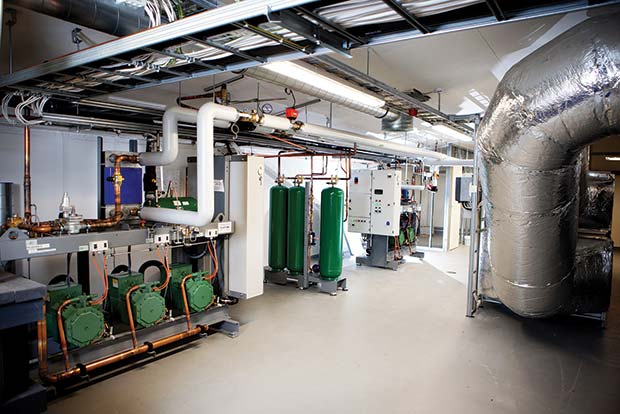Introduction

The refrigeration industry is facing challenges with regard to the fluids it can use with global warming potential (GWP) being at the heart of the issue. Whilst the race is on to identify the best solutions for the future, what about today? A simple change now can have an immediate effect on environmental impact. Changing away from R404A to a lower GWP refrigerant such as KLEA 407A can bring dramatic cost and environmental savings to retailers.
Where are we today?
Hydrofluorocarbon (HFC) refrigerants remain under close scrutiny by regulators and environmentalists, with many alternatives being proposed to minimise environmental impact. Improvements in refrigerant and system energy efficiencies, together with reducing the direct global warming effect of any refrigerant through minimisation of losses, remain key priorities.
Today, there seems to be no clear view of what the ultimate solution will be; indeed there is unlikely to be a one-size-fits-all product. Instead, the future will almost certainly involve a variety of application specific options – including use of the so called “natural” refrigerants such as carbon dioxide, ammonia and hydrocarbons, and the new family of unsaturated HFCs, commonly referred to as hydrofluoroolefins (HFOs). Whilst all of these refrigerants offer reduced GWP in comparison with many of the currently used HFCs, it is unclear how energy efficient they will prove to be across the range of application areas. Product safety, particularly flammability, also has to be taken into consideration in selecting the most appropriate refrigerant for a given application.
Future regulation
What is clear is that change is coming. The revisions to the European F Gas regulation are approaching the final stages of agreement. HFCs will be subject to a cap and phase down process from 2015, but more significantly, a ban on the use for service of virgin HFCs with a GWP greater than 2500 will come into force from 2020 putting pressure on R404A and R507.
Which direction?
Against this backdrop it is all too easy to look for a solution that will solve all the issues straight away. However, it will take time to introduce new technologies and working fluids – for reasons of both cost and practicality. Rather than wait, there are several steps that the industry can take in the short to medium term that can have an immediate and significant effect on reducing environmental impact.
Enter KLEA 407A
KLEA 407A was originally launched as a CFC 502 replacement by Mexichem Fluor (in the days when it was part of ICI). KLEA 407A is a ternary blend of R32, R125 and R134a, and developed to give the best possible combination of performance, energy efficiency and environmental impact. In terms of performance, KLEA 407A is an ideal candidate for replacing R404A, having similar capacity across a range of conditions, but offering a distinct efficiency advantage, not to mention a GWP almost half that of R404A.
KLEA 407A is widely approved, widely understood and widely available.

Small change, Big effect
Given the regulatory and environmental landscape, moving to lower GWP refrigerants is becoming a priority for European supermarkets. Whilst various new technologies and refrigerants are being trialled, a major and immediate impact can be made on emissions by the use of KLEA 407A in existing systems.
M&S in the UK has converted 450 stores from R404A to R407A over the last 4-5 years. This, and other work, has resulted in a 46% reduction in carbon emissions. KLEA 407A is being trialled across Europe, and the results so far are very similar to the experience of M&S.
The conversion process is straightforward and written procedures and guidance are available from Mexichem. Good refrigeration practice will dictate that some seals, may benefit from a change at the same time, but no major system component changes are generally required. KLEA 407A is fully compatible with the lubricants already in any HFC system.
Energy efficiency savings in the region of 8-10% are being seen, although this benefit is very much system specific and may vary from system to system. These savings, coupled with a lower GWP refrigerant and re-commissioning of a system is leading to significant reductions in energy consumptions and overall carbon footprint.
The way ahead…
Alongside the benefits of moving to KLEA 407A from R404A, supermarkets are trialling a variety of longer-term solutions including HFOs and their blends. Whilst CO2 and Hydrocarbons are likely to play a part in this solution, given their very low GWP, the industry will need time to evaluate the best way to make use of them. It may well be that existing lower GWP HFCs will play their part in these developments, as they are already doing in CO2 cascade systems. Both KLEA 407A and R134a are being used in the 10 stages in such systems today.
Whatever the long term future holds, the industry can take action now that does make immediate and beneficial savings in carbon emissions. Mexichem Fluor is promoting KLEA 407A throughout Europe and in other regions as a major step forward on the road towards reducing the environmental impact of supermarket refrigeration system usage.
For more information and technical data contact Martyn Cooper at Mexichem Fluor on 07860 378766 or martyn.cooper@mexichem.com
Mexichem Fluor
Martyn Cooper
Tel: 07860 378766
email: martyn.cooper@mexichem.com




Comments are closed.